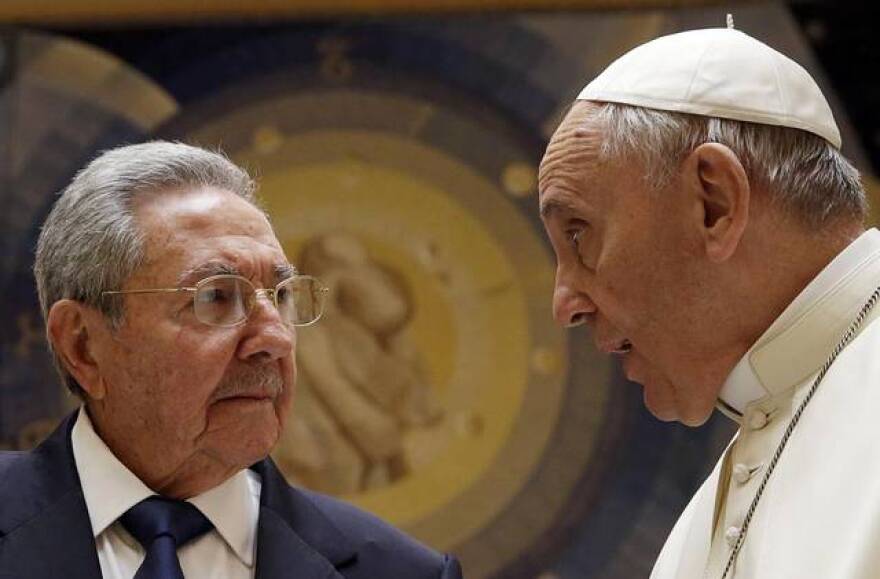Pope Francis’ visit to Cuba this weekend showcases the island’s Roman Catholic recovery after half a century of communism.
But that narrative is misleading. In reality, Catholicism wasn’t all that vibrant in Cuba before communism.
You might not have believed that if you watched South Florida’s Cuban Catholics last week hold their annual procession for Cuba’s patron saint. Men in straw peasant sombreros carried a statue of the Virgin Mary known as Our Lady of Charity through Bank United Center in Coral Gables – a prelude to Monday, when Francis will pray at Our Lady of Charity’s actual shrine near Santiago, in southeast Cuba.
RELATED: Five Things We Learned About Pope Francis' Upcoming Visit To Cuba
La Virgen de la Caridad, as she’s called in Spanish, is supposed to symbolize the island’s Catholic roots – which Fidel Castro and his communist revolution tore out in the 1960s. Castro declared Cuba an atheist state in 1961, shutting down Catholic schools and exiling hundreds of priests.
Cubans like 32-year-old Carlos Hernández heard that political dogma growing up.
“In school,” Hernández recalls, “they described the Church like an enemy of the human race.”
The Church had to explain to a lot of Cubans just exactly what a pope was. –Miami Archbishop Thomas Wenski
But in Cuba, compared to the rest of Latin America, tearing out Catholicism didn’t require a lot of effort – with or without a revolution.
“If you consider attendance at religious services like Mass,” says Jorge Duany, who heads the Cuban Research Institute at Florida International University in Miami, “then Cuba was not very Catholic” even before Castro took power in 1959.
In the 1950s, “the estimates run from 10 percent of the population who regularly attended church,” says Duany. “Most Cubans weren’t married in the Catholic Church; they did not follow Catholic dogmas. There weren’t enough priests, and in many parts of Cuba there simply were no temples.”
That lack of real Catholic devotion in Cuba’s DNA has made it hard for popes – even one as popular as Francis – to exert influence over the Cuban government on issues like human rights.
In fact, Miami Archbishop Thomas Wenski remembers that when the late Pope John Paul II visited Cuba in 1998, “the Church had to explain to a lot of Cubans just exactly what a pope was.” That wasn’t the case in John Paul’s native Poland, even under communist rule.
SPANISH CROWN
So why has Cuba’s bond with Catholicism been so historically weak? After all, Cuba was one of the jewels of the fanatically Catholic Spanish Empire.
One answer lies in the early 19th century, when Latin America won independence from Spain. Except Cuba. In most countries, Catholic clergy sided with the locals. But in Cuba “the Church [was] aligned with the Spanish crown,” says Sister Ondina Cortes, a Cuban-American nun and theology professor at St. Thomas University in Miami Gardens.
That pro-imperial stance created a lasting mistrust of the Catholic Church among Cubans. The Church also had to compete with Afro-Cuban religions like Santería. And Cuba’s Caribbean locale made it a port of call for more liberal thinking coming in from 19th-century Europe.
“It was the beginning of secular tendencies in Cuba,” says Cortes. “A very humanistic understanding of life.”
But Cortes says Cubans who fled the 1959 revolution included a cadre of more genuinely devout Catholics emerging in Cuba at that time.
“That generation of committed young Catholics came to Miami,” she says. “And I think the flourishing of the Catholic Church in Miami is indebted to them.”

Meanwhile, in the 1990s, Cuba faced economic catastrophe – and pragmatism suddenly looked more appealing than atheism. Fidel and his brother Raúl Castro – who had both attended Catholic schools – asked the Church to help struggling Cubans.
That decision to let the Church rebuild itself changed the lives of Cubans like Carlos Hernández. As a kid in Camagüey, he’d learned to reject his family’s Catholic faith.
“I remember they baptized me around 7 years old,” says Hernández. “And I had to keep it a secret, because if you said you’re a Catholic you were in trouble.”
Yet as Hernández watched the Cuban church re-emerge, so did his Catholicism.
Five years ago he was serving as a radiologist in Venezuela when he took asylum in Catholic churches there and defected to the U.S. with his wife and two children.
Hernández now owns a cleaning company in Boynton Beach. He says for once, Catholicism is taking a real, popular hold in Cuba. And he thinks that – and the fact that Francis is the first Latin American pope – mean the Church can now influence reform there.
“This pope is coming talking about reconciliation,” says Hernández. “That is what we want. We don’t want confrontation. We want dialogue.”
Pope Francis and Raúl Castro, who is today Cuba’s president, will meet on Sunday.
The Church is still in no position to spark a Cuban Spring. But even so, it’s time to see if being more Catholic can help make Cuba more democratic.






